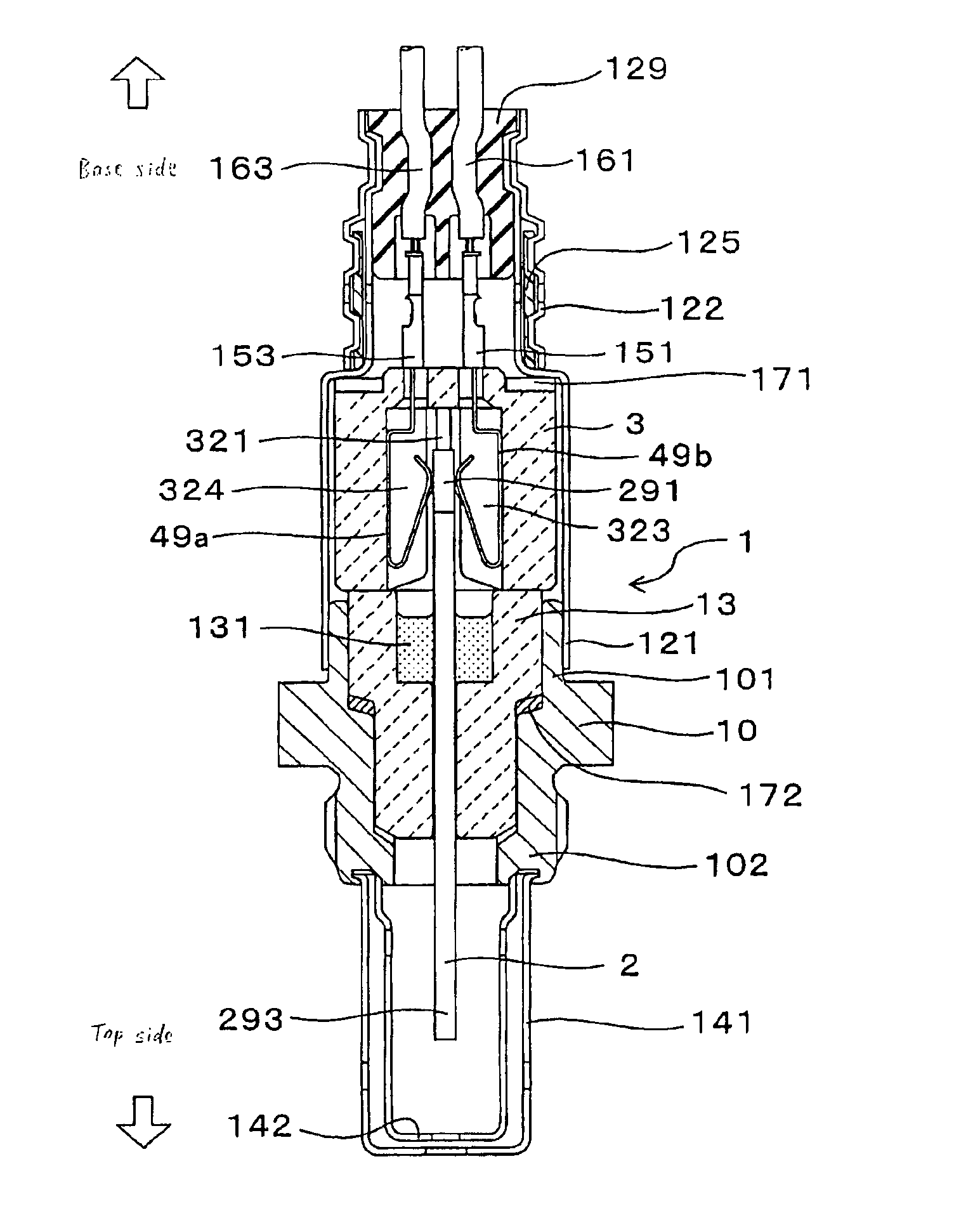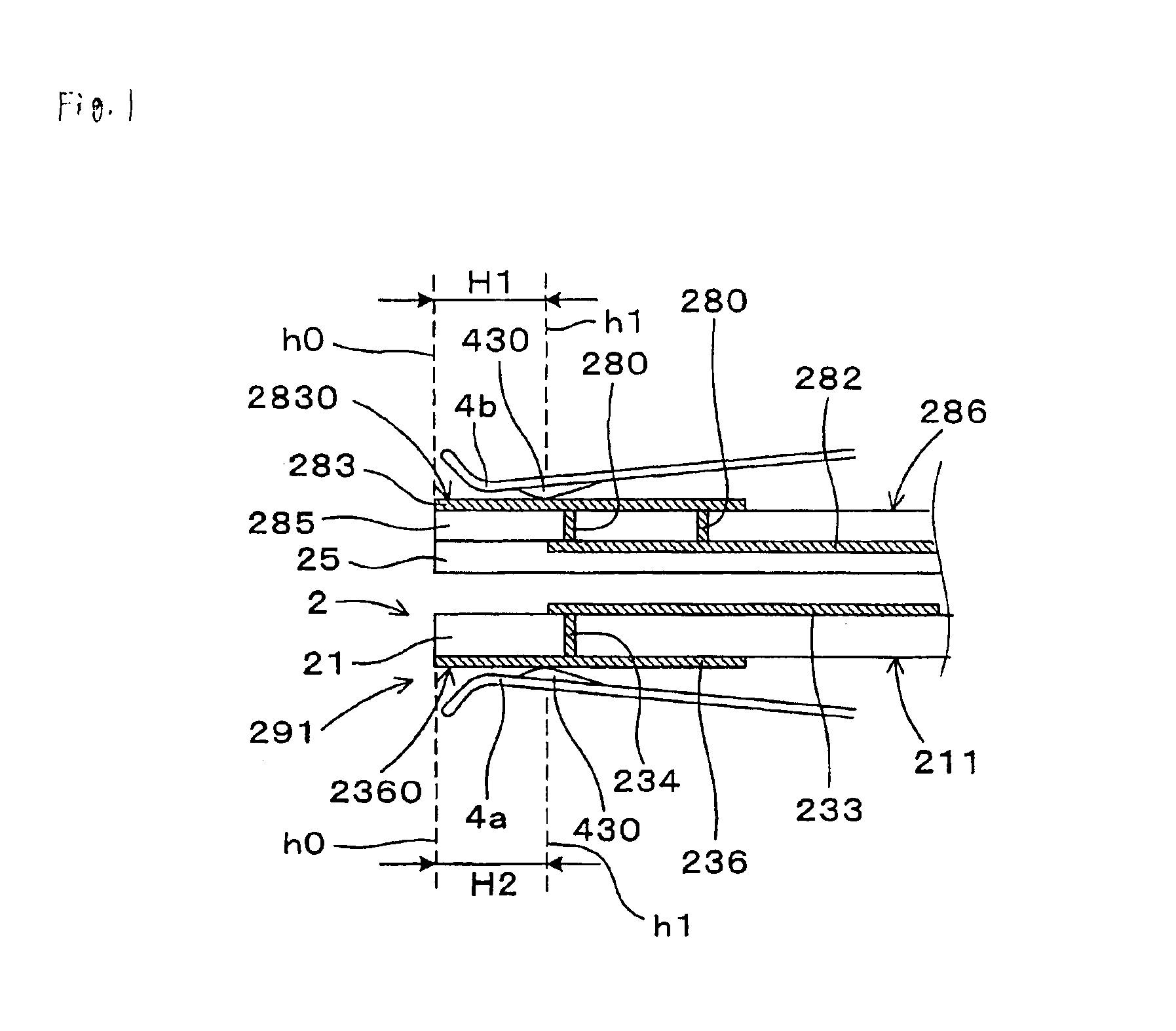Contact slidable structure with a high durability
- Summary
- Abstract
- Description
- Claims
- Application Information
AI Technical Summary
Benefits of technology
Problems solved by technology
Method used
Image
Examples
first embodiment
As shown in FIGS. 1-11, the contact slidable structure formed between the ceramic element 2 and the resilient terminals 4a,4b,49a and 49b includes the ceramic body 20, the inner leads 282 and 233 build in the ceramic body 20, the terminal electrodes 283 and 236 formed on an upper surface of the ceramic body 20, and the conductive through holes 280 and 234 extending through the inner leads 282 and 233 and the terminal electrodes 283 and 236, respectively, to form an electrical connection therebetween, in which the resilient terminals 4a,4b,49a and 49b are placed to be slidable on the upper surface 2830 and 2360 of the terminal electrodes 283 and 236, respectively. The conductive through holes 280 and 234 are not formed within the contact slidable areas H1 and H2 where the resilient terminals 4a,4b,49a and 49b are slidable on the terminal electrodes 283 and 236, respectively.
As shown in FIG. 6, the ceramic element 2 works as a gas sensing element which has the single electrochemical c...
second embodiment
In the second embodiment, as shown in FIGS. 12A and 12B, a contact slidable structure is formed between the ceramic element 5 and the resilient terminal 59a.
The ceramic element 5 includes the ceramic body 50, the inner lead 501, and the conductive through hole 52. The resilient terminal 59a has a width identical with or more than that of the ceramic element 5.
As shown in FIG. 12B, the contact slidable area H3 extends over the ceramic element 5 in a lateral direction thereof, indicated by the sign W. As shown in FIG. 12B, the contact slidable area H3 is defined as a square area by the dotted lines a1 and a2, i.e. the surfaces of the terminal electrode 51 and the ceramic body 50 between the dotted line a1 on which the resilient terminal 59 comes into contact with the terminal electrode 51 and the dotted line 2 on which the resilient terminal 59 stops, upon joining the ceramic element 5 with the resilient terminal 59. Thus, as shown in FIGS. 12A and 12B, the conductive through hole 52...
third embodiment
The third embodiment of the invention will be described.
In this embodiment, as shown in FIG. 13, the width of the resilient terminal (not shown) is narrower than that of the ceramic element 55. The width of the contact slidable area is equivalent to the width of the resilient terminal (not shown), and the contact slidable area is indicated by sign B surrounded by a dotted line in FIG. 13.
The contact slidable area B is selected, so that the conductive through hole 52 is out of alignment to the contact slidable area B in a lateral direction of the ceramic element 55, or leftward of the contact slidable area B in FIG. 13.
In other words, the conductive through hole 52 may be formed leftwards or outside the contact slidable area B in the lateral direction of the ceramic element 55.
The rest of the arrangement of the third embodiment is substantially identical with that of the first embodiment. Hence, the third embodiment brings substantially the same functions and effects.
PUM
 Login to View More
Login to View More Abstract
Description
Claims
Application Information
 Login to View More
Login to View More - R&D
- Intellectual Property
- Life Sciences
- Materials
- Tech Scout
- Unparalleled Data Quality
- Higher Quality Content
- 60% Fewer Hallucinations
Browse by: Latest US Patents, China's latest patents, Technical Efficacy Thesaurus, Application Domain, Technology Topic, Popular Technical Reports.
© 2025 PatSnap. All rights reserved.Legal|Privacy policy|Modern Slavery Act Transparency Statement|Sitemap|About US| Contact US: help@patsnap.com



